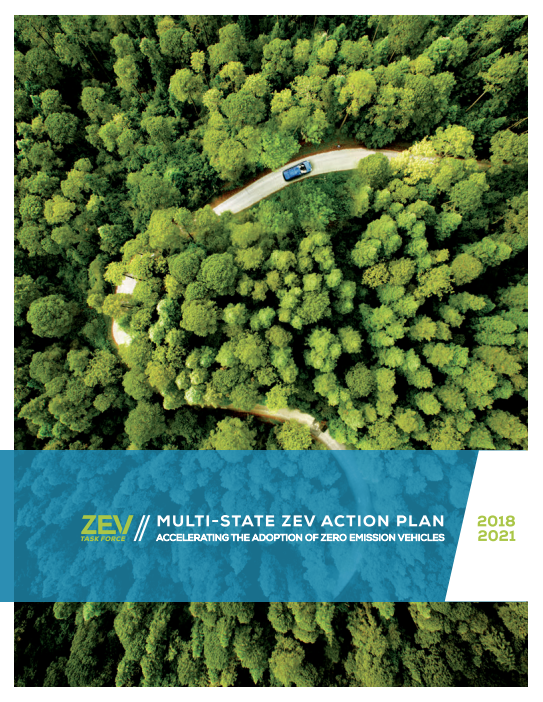July 5, 2018
The nine states of the Multi-State Zero-Emissions Vehicle (ZEV) Task Force released a new action plan this week outlining priority actions to rapidly accelerate the adoption of ZEVs in their states.
 The ZEV Action Plan for 2018-2021—a follow-up to a 2014 action plan—is specific to light-duty vehicles, which are the single largest contributor to greenhouse gas emissions in the Task Force states. (Those states are California, Connecticut, Maryland, Massachusetts, New York, Oregon, Rhode Island, Vermont, and New Jersey which joined earlier this year.) It provides 80 recommendations for state governments, automakers, dealers, utilities, and the ZEV industry to accelerate adoption ahead of their self-imposed 2025 deadline to put 3.3 million ZEVs on the road and achieve a 15.4% market share.
The ZEV Action Plan for 2018-2021—a follow-up to a 2014 action plan—is specific to light-duty vehicles, which are the single largest contributor to greenhouse gas emissions in the Task Force states. (Those states are California, Connecticut, Maryland, Massachusetts, New York, Oregon, Rhode Island, Vermont, and New Jersey which joined earlier this year.) It provides 80 recommendations for state governments, automakers, dealers, utilities, and the ZEV industry to accelerate adoption ahead of their self-imposed 2025 deadline to put 3.3 million ZEVs on the road and achieve a 15.4% market share.
A little background: Under Section 209(b) of the Clean Air Act, California is the only state authorized to adopt motor vehicle emission standards more stringent than the federal standards, the result of negotiations on vehicle emissions standards between California and the Obama Administration in 2012. Section 177 of the Act allows other states to adopt California’s standards, which eight states have done. California’s Advanced Clean Cars Program, among other things, requires major car manufacturers to sell an increasing percentage of ZEVs in a given year, ultimately resulting in over 15 percent of all new cars, pickups and SUVs sold in the state to be ZEVs by 2025. ZEVs include battery-electric vehicles, plug-in hybrid electric vehicles, and hydrogen fuel cell electric vehicles.
In 2013, California and the seven other states at the time (New Jersey joined later) came together to form the Multi-State ZEV Task Force with a Memorandum of Understanding committing them to coordinate action to ensure they met their ZEV goals. The MOU spells out joint actions the states would take, including promoting the availability and marketing of electric vehicles, providing consumer incentives, increasing ZEVs in public fleets, and promoting ZEV infrastructure planning and investment, among others.
With roughly 700,000 ZEVs sold in their states since 2011, the Task Force members are a long way away from meeting their goal. As the plan notes, “Most consumers buying ZEVs still fall into the category of enthusiastic early adopters, and penetration of ZEV technology into the mainstream automobile market still falls far short of what is needed to combat climate change.”
The new action plan is meant to prioritize actions the Task Force thinks will give them the most bang for their buck in getting more ZEVs on the road. The recommendations are organized into five categories:
- Consumer education and outreach,including supporting the brand-neutral Drive Change. Drive Electric.campaign and encouraging state, local, and grassroots efforts to increase consumer experience with ZEVs, such as through ride and drives.
- Charging and hydrogen fueling infrastructure,including facilitating public and private investment in the development of charging/fueling infrastructure (such as by revising building codes and incentivizing workplace installation) to build consumer confidence and support rapid growth in demand.
- Consumer purchase incentives,including advocating for continued availability of federal tax credits, continuing to offer existing state rebates and tax credits, and considering new programs aimed at moderate and lower income consumers.
- Leading by example with public light-duty fleets,including setting near- and long-term electrification goals and procurement policies and offering financial incentives for local governments to acquire more ZEVs.
- Working with dealerships,to develop and share best practices and identify specific collaboration opportunities to support sales.
It’s no coincidence that most of the recommendations target the demand side of the transaction—how to get more people to want to buy a ZEV. Since the metric of greatest concern is the percentage of vehicle sales, the states need to couple any requirement put upon auto manufacturers with demand-side policies that will get people to make a purchase. In fact, the original MOU was full of buyer incentives, including a recommendation of point-of-purchase rebates (rather than tax credits the purchaser may not see for several months) and state support for the continuation of the federal tax credits for plug-in electric and hydrogen fuel cell electric vehicles.
The new action plan recognizes the twin problems that many people are not aware of these incentives, and that the existing incentives may not be enough. It thus recommends a more robust education and outreach effort on the part of all stakeholders, expanding charging and hydrogen fueling infrastructure to reduce “range anxiety,” and crafting new incentives specifically targeting moderate and lower income consumers.
Will it be enough? It’s hard to imagine a scenario where ZEV sales in these states rise from 1-4 percent of total sales in 2017 to 15.4 percent by 2025. A 2017 report found that California is on track to meet its 2025 goal, but the state is far outpacing the others in the Task Force—and as of 2017, automakers can no longer put excess California sales towards meeting the other states’ requirements.
Read the full action plan here. Eno recently held a webinar on the federal greenhouse gas emissions standards, which are now under reconsideration by the Trump Administration, and what that might mean for the California standards. Click here to watch a recording.

 The
The 

